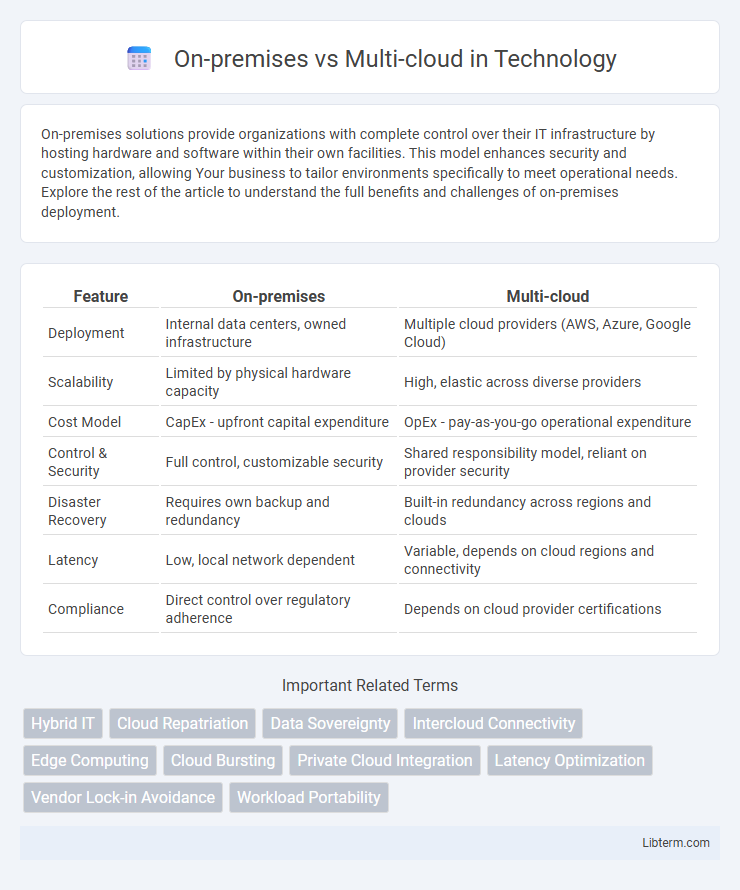On-premises solutions provide organizations with complete control over their IT infrastructure by hosting hardware and software within their own facilities. This model enhances security and customization, allowing Your business to tailor environments specifically to meet operational needs. Explore the rest of the article to understand the full benefits and challenges of on-premises deployment.
Table of Comparison
| Feature | On-premises | Multi-cloud |
|---|---|---|
| Deployment | Internal data centers, owned infrastructure | Multiple cloud providers (AWS, Azure, Google Cloud) |
| Scalability | Limited by physical hardware capacity | High, elastic across diverse providers |
| Cost Model | CapEx - upfront capital expenditure | OpEx - pay-as-you-go operational expenditure |
| Control & Security | Full control, customizable security | Shared responsibility model, reliant on provider security |
| Disaster Recovery | Requires own backup and redundancy | Built-in redundancy across regions and clouds |
| Latency | Low, local network dependent | Variable, depends on cloud regions and connectivity |
| Compliance | Direct control over regulatory adherence | Depends on cloud provider certifications |
Introduction to On-premises and Multi-cloud
On-premises infrastructure refers to IT resources hosted within a company's physical facilities, offering direct control over hardware, security, and data management. Multi-cloud environments utilize multiple cloud service providers simultaneously, enhancing flexibility, resilience, and risk mitigation across public and private clouds. Enterprises adopting multi-cloud benefit from optimized workload distribution and reduced dependency on a single vendor.
Key Differences Between On-premises and Multi-cloud
On-premises infrastructure involves hosting servers and data within a company's own physical facilities, offering complete control over hardware, security, and data management. Multi-cloud leverages multiple public cloud providers like AWS, Azure, and Google Cloud to enhance flexibility, scalability, and disaster recovery, reducing dependence on a single vendor. Key differences include cost dynamics, with on-premises requiring significant upfront capital expenditure versus the operational expenses of multi-cloud, and control levels, where on-premises provides more direct oversight compared to the distributed nature of multi-cloud environments.
Cost Considerations: On-premises vs Multi-cloud
On-premises infrastructure requires significant upfront capital expenditure for hardware, maintenance, and dedicated IT staff, often leading to higher fixed costs. Multi-cloud environments offer flexible, pay-as-you-go pricing models that optimize operational expenses by scaling resources based on demand and workload. Cost considerations also include potential savings in disaster recovery, data redundancy, and avoiding vendor lock-in with multi-cloud strategies compared to the localized investment risks of on-premises setups.
Security Implications and Compliance Challenges
On-premises environments offer direct control over physical security and data governance, simplifying compliance with strict regulatory standards such as GDPR and HIPAA. Multi-cloud architectures introduce complexities in security management due to varying provider protocols and shared responsibility models, increasing risks like data breaches and inconsistent policy enforcement. Ensuring compliance requires unified visibility, robust encryption, and automated auditing tools to address disparate cloud configurations and evolving regulatory demands.
Scalability and Flexibility Comparison
On-premises infrastructure often limits scalability and flexibility due to fixed hardware capacity and maintenance constraints, requiring significant investment and time to upgrade. Multi-cloud environments enable dynamic scaling by leveraging multiple cloud providers, offering on-demand resources that adjust to workload fluctuations and diverse application needs. Flexibility in multi-cloud setups allows seamless integration of different platforms and services, supporting rapid innovation and disaster recovery, which on-premises systems typically struggle to achieve efficiently.
Performance and Reliability Factors
On-premises infrastructure delivers consistent performance by providing dedicated resources and low-latency access to local data centers, which is critical for latency-sensitive applications. Multi-cloud environments enhance reliability through redundancy and failover capabilities across multiple cloud providers, minimizing downtime risks caused by individual service outages. Performance in multi-cloud setups depends on efficient workload distribution and network optimization to mitigate inter-cloud latency challenges.
Management and Maintenance Requirements
On-premises infrastructure demands dedicated IT teams for hardware maintenance, software updates, and security monitoring, ensuring full control but requiring significant resource investment. Multi-cloud environments require expertise in managing multiple cloud platforms, integration tools, and consistent security policies across providers, which can increase complexity but offer scalability and redundancy. Effective multi-cloud management relies heavily on automation and centralized monitoring solutions to reduce operational overhead and maintain performance.
Integration with Existing Systems
On-premises environments offer seamless integration with existing legacy systems through direct hardware control and local network connectivity, ensuring minimal latency and enhanced data security. Multi-cloud architectures enable flexible integration by leveraging APIs and middleware to connect diverse platforms, facilitating scalability and disaster recovery without extensive infrastructure overhaul. Choosing between the two depends on the organization's need for control, compatibility with legacy applications, and long-term cloud adoption strategy.
Use Cases: When to Choose On-premises or Multi-cloud
On-premises solutions are ideal for organizations requiring stringent data security, low-latency applications, or regulatory compliance mandates such as HIPAA or GDPR. Multi-cloud environments offer flexibility for businesses needing global scalability, disaster recovery, or workload distribution across AWS, Azure, and Google Cloud platforms. Choosing on-premises suits predictable, stable workloads with high control needs, while multi-cloud excels in dynamic, variable-demand scenarios and hybrid IT strategies.
Future Trends in Cloud Adoption Strategies
Future trends in cloud adoption strategies indicate a growing preference for multi-cloud environments due to increased flexibility, risk mitigation, and cost optimization. Organizations are leveraging on-premises infrastructure combined with multiple cloud providers to enhance data sovereignty, compliance, and workload portability. Advanced technologies like AI-driven cloud management and edge computing integration are driving the evolution from traditional on-premises setups to hybrid and multi-cloud architectures.
On-premises Infographic

 libterm.com
libterm.com